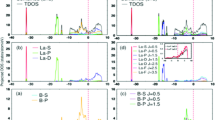Abstract
A density functional theory calculation via first principle approach of electronic and magnetic properties of f-electron systems is a matter of pronounced challenge in the materials research due to the struggle in simultaneous stability to delight both the localized and itinerant states. In f-electron systems, f-states show a significant part in defining their chemical and physical properties. In the present investigations, spin-polarized electronic and magnetic calculations have been done for TbO2. We have employed the PBE-GGA and Tb-mBJ exchange correlation functional for the calculation along with the spin–orbit coupling effect. The band gap of TbO2 ~ 5.8 eV for spin up states with a magnetic moment of ~ 7.0 μB per unit cell was estimated using the PBE-GGA exchange correlation which is in well agreement with previous theoretical studies. The maximum absorption and optical conductivity lies within the visible and UV region with refractive index ~ 3.5 at zero photon energy. These properties of TbO2 show the ferromagnetic semiconductor character. We have also observed the effect of spin–orbit coupling (SOC) on opto-electronic properties of the compound. Density of states and band structure shows the splitting of the f-states of Tb atoms on inclusion of SOC. The overall electronic, magnetic and optical properties of TbO2 are suitable for its use in solid state and opto-electronic devices.









Similar content being viewed by others
Data Availability Statement
This manuscript has associated data in a data repository. [Authors’ comment: All data included in this manuscript are available upon request by contacting the corresponding author.]
References
K. A. Gschneidner, L. Eyring (eds.) Handbook on the Physics and Chemistry of Rare Earths (North-Holland, Amsterdam, 1978-2010), vol. 1–40
C.I. Hancox, S.C. Doret, Nature (London) 431, 281 (2004)
A. Rosenflanz, M. Frey, B. Endres, Nature (London) 430, 761 (2004)
Z.L. Fu, S.H. Zhou, S.Y. Zhang, J. Phys. Chem. B 109, 14396 (2005)
K.M. Wong, Results Phys. 7, 1308 (2017)
A.M. dos Santos, F.M.B. Marques, L.D. Carlos, J. Mater. Chem. 16, 3139 (2006)
S.Y. Savrasov, G. Kotliar, E. Abrahams, Nature 410, 793 (2001)
D.M. Gruen, W.C. Koehler, J.J. Katz, J. Am. Chem. Soc. 73, 1475 (1951)
J. Zhang, R.B. Von Dreele, L. Eyring, J. Solid State Chem. 104, 21 (1993)
F. Ahmadpour, Y. Mozharivskyj, J. Alloys Compd. 452, 254 (2008)
S.V. Belaya et al., Chem. Vap. Depo. 21, 150 (2015)
H.A. Miran et al., Mater. Res. Express 5, 085901 (2018)
S. Bernal et al., Chem. Commun. M1997, 1545 (1997)
S. Bernal et al., Catal. Today 53, 607 (1999)
M.B. Kanoun, A.H. Reshak, N.K. Bouayed, S. Goumri-Said, J. Magn. Maters 324, 1397 (2012)
F.D. Murnaghan, Proc. Natl. Acad. Sci. USA 244, 30 (1944)
W. Kohn, L. Sham, Phys. Rev. A 140, 113 (1965). https://doi.org/10.1103/Physrev.140.A1133
P. Blaha, K. Schwarz, G. Madsen, D. Kvasnicka, J. Luitz, WIEN2k, An Augmented Plane Wave Plus Local Orbitals Program For Calculating Crystal Properties (Vienna University Of Technology, Austria, 2001)
D.J. Singh, Phys. Rev. B 82, 205102 (2010)
S. Kumar, N. Kumar, K. Yadav, A. Kumar, R.P. Singh, Optik Int. J. Light Elecctron. Opt. 207, 163797 (2020)
C.I. Silva Filho, A.L. Oliveira, S.C.F. Pereira, G.F. de Sá, L.L. da Luz, S. Alves Júnior, Dalton Trans. 48, 2574–2581 (2019)
J. Osuwa, C. Oriaku, C. Atuloma, Chalcogenide Lett. 7, 383 (2010)
J. Osuwa, C. Oriaku, O. Uko, Chalcogenide Lett. 7, 449 (2010)
D.R. Penn, Phys. Rev. 128, 2093 (1962)
O. Pulci, M. Palummo, V. Olevano, G. Onida, L. Reining, R.D. Sole, Phys. Stat. Sol. 188, 1261 (2001)
S. Berrah, A. Boukortt, H. Abid, Physica E Low. Syst. Nanostruct. 41, 701 (2009)
Acknowledgements
One of the authors, Arvind Kumar also wants to acknowledge the financial support received from the UGC in form of UGC-BSR Research Start-up Grant (F.30-374/2017(BSR)), New Delhi, India.
Author information
Authors and Affiliations
Contributions
AK, MK: writing-original draft, formal analysis; RPS: review and formal analysis.
Corresponding authors
Ethics declarations
Conflict of interest
The authors declare that they have no known competing financial interests or personal relationships that could have appeared to influence the work reported in this paper.
Rights and permissions
About this article
Cite this article
Kumar, A., Kumar, M. & Singh, R.P. Effect of spin–orbit coupling on opto-electronic and magnetic properties of rare-earth terbium dioxide (TbO2): first principle calculations. Eur. Phys. J. Plus 135, 939 (2020). https://doi.org/10.1140/epjp/s13360-020-00901-y
Received:
Accepted:
Published:
DOI: https://doi.org/10.1140/epjp/s13360-020-00901-y




